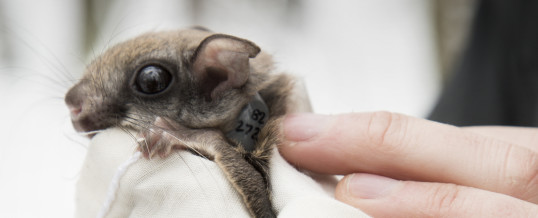In West Virginia, conservationists have set out to revive heavily logged red spruce forests in hopes of saving an endangered flying squirrel from extinction. Cordie Diggins, a Virginia Tech doctoral student and an IGC Fellow, is featured in the following Nature Conservancy Magazine article.
Flying High
“Craig Stihler holds the squirming rodent in his gloved hands. “It’s a biter,” warns the bespectacled biologist as he handles the animal using only calm, deliberate movements. With its impossibly large eyes built for seeing in the dark, the West Virginia northern flying squirrel looks and acts like an agitated Muppet.
And rightfully so: A few minutes ago, this young female specimen was napping in one of hundreds of nest boxes that Stihler and other researchers installed throughout the Monongahela National Forest. But now she’s being weighed, ear-tagged and measured by a small group of scientists.

One of them—Virginia Tech doctoral student Corinne Diggins—blows in the squirrel’s face, trying to stop it from writhing in Stihler’s hand long enough for her to slip a radio collar around its neck. The animal finally holds still after a Forest Service technician gamely offers the finger of his glove for the squirrel to gnaw on, which allows Diggins to crimp the collar in place. Once she is done, Stihler releases the squirrel onto a tree trunk. It darts up into the canopy, then freezes in place, waiting for the group to leave.
A biologist with the West Virginia Division of Natural Resources, Stihler has held more West Virginia northern flying squirrels than just about anyone. He has been studying the animals since 1985, when this subspecies of the northern flying squirrel was listed as endangered under the federal Endangered Species Act. At the time, scientists could find the squirrel at only a handful of sites in West Virginia, and its only known habitat had been reduced to a small fraction of its historical footprint in the area. To make things worse, not much was known about the animal—including what it ate, where it slept and how it differed from its more common cousin, the northern flying squirrel, which ranges across North America. With so few of the feisty, nocturnal animals to study, figuring out why the squirrel had declined—let alone how to save it—was going to require some sleuthing.

Only three decades later, the outlook for the flying squirrel’s survival has changed dramatically. The species is no longer endangered and was delisted in 2013—a remarkable feat, given how few squirrels remained and how little was known about them. The story of the squirrel’s turnaround isn’t about saving just one species; it’s the story of the restoration of an entire landscape that had become unbalanced by more than a century of logging and mining.”
Read the full story here: http://shar.es/Tn1Ml
Thanks to Patrick Cavan Brown for use of his photographs.